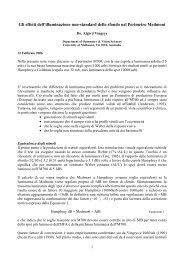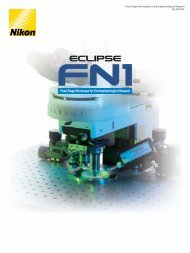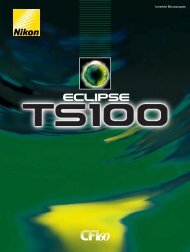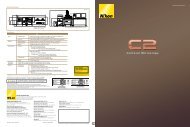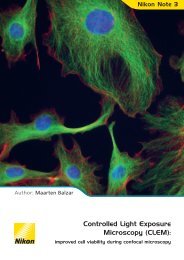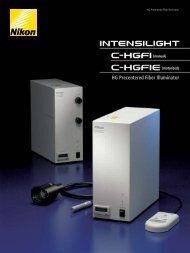Inverted Research Microscope ECLIPSE Ti - Nikon Instruments
Inverted Research Microscope ECLIPSE Ti - Nikon Instruments
Inverted Research Microscope ECLIPSE Ti - Nikon Instruments
You also want an ePaper? Increase the reach of your titles
YUMPU automatically turns print PDFs into web optimized ePapers that Google loves.
<strong>Inverted</strong> <strong>Research</strong> <strong>Microscope</strong> <strong>ECLIPSE</strong> <strong>Ti</strong>
4<br />
<strong>Ti</strong>: Stress-Free Operation<br />
High-speed Motorized Control<br />
and Acquisition<br />
The synchronized control of many motorized components such as the nosepiece,<br />
fluorescence filters, shutters, condenser turret and stage, allows researchers to use<br />
the microscope for a wide range of automated multi-dimensional experiments.<br />
Faster device movement and image acquisition decrease overall light exposure and<br />
subsequent photo-toxicity, leading to more meaningful data.<br />
Enhanced speed of individual motorized components<br />
Operation and/or changeover speed of objectives, filter cubes, XY stage, excitation/barrier filters has been greatly enhanced,<br />
realizing stress-free operational environment that enables researchers to focus on observations and image capture routines.<br />
The newly developed controller that memorizes and reproduces observation conditions and the joystick that enables<br />
stage control at will make the microscope feel like an extension of your eyes and hands.<br />
● High-speed XY stage movement ● High-speed Piezo Z stage movement ● High-speed epi-fl filter changeover<br />
<strong>Nikon</strong>-exclusive high-speed encoded stage <strong>Nikon</strong>-specified Piezo Z specimen stage <strong>Nikon</strong> filter dichroic cube turret<br />
Newly developed digital Controller Hub significantly increases<br />
motorized accessory speed by reducing the communication overhead<br />
time between components, boosting total operation speed.<br />
PC control and automation of the <strong>Ti</strong>’s motorized components are optimized to reduce the respective communication time between<br />
action commands and movements producing high-speed total control. By adding firmware intelligence to the microscope,<br />
total operation time of the motorized components is reduced. For example, the total time for continuous image acquisition in<br />
three modes (two-channel fluorescence and phase contrast) with illumination shutter control is greatly reduced enhancing cell viability.<br />
● Control process<br />
■ Conventional model<br />
Signal<br />
communication<br />
■ <strong>Ti</strong>-E<br />
Signal<br />
communication<br />
Stage movement<br />
Signal PFS Signal<br />
Filter changeover<br />
Signal<br />
Image capture<br />
communication correction communication<br />
communication<br />
Stage<br />
movement<br />
PFS<br />
correction<br />
Filter<br />
changeover<br />
Image<br />
capture<br />
Remarkably Fast Image Acquisition!<br />
Screening image capture of 96 wells in three modes (two-channel<br />
fluorescence and phase contrast) is possible at a speed of more than<br />
twice that of conventional models.<br />
Multipoint snapshots of HeLa cells transiently expressing Venus-tubulin and<br />
mCherry-actin and stained with Hoechst33342 and DiD. (All in pseudo-color)<br />
Photos courtesy of: Kenta Saito and Takeharu Nagai,<br />
<strong>Research</strong> Institute for Electronic Science, Hokkaido University
14<br />
Motorized Elements for Comfortable Observation<br />
Fast, automatic operation by integrated control<br />
with NIS-Elements software<br />
<strong>Microscope</strong>s have evolved from merely observation devices to software-controlled data acquisition devices.<br />
<strong>Nikon</strong>’s <strong>Ti</strong> series not only features fast and comfortable motorized operation, but it also realizes acquisition of<br />
reliable data by controlling all motorized components for automatic imaging with the NIS-Elements imaging software.<br />
● <strong>Nikon</strong> motorized XY stage<br />
Fast and precise positioning is possible. Suitable for multipoint timelapse<br />
observation. (Available as encoded or non-encoded versions)<br />
● Motorized nosepiece<br />
Six objective positions can be changed.<br />
(Photo shows motorized PFS nosepiece)<br />
● Motorized condenser turret<br />
Motorized condenser changeover is possible.<br />
● Motorized barrier filter wheel<br />
Fluorescence barrier filter positions (8 positions—using 25mm<br />
filters) can be changed at a high speed of 0.15 sec. per position.<br />
● Piezo Z stage<br />
High-speed, precise Z-axis control is possible.<br />
(Manufactured by Mad City Labs, Inc.)<br />
● Motorized filter rotating turret<br />
Position of fluorescence filter cubes can be changed in<br />
0.3 sec. per position. (Photo shows high-performance type)<br />
● Remote controller<br />
<strong>Microscope</strong> status can be confirmed with icons.<br />
The microscope can be operated via the touch panel.<br />
<strong>Ti</strong>-E can be fully motorized with the HUB-A<br />
Communication speed is dramatically<br />
increased through proprietary motorization<br />
algorithms, innovatively accelerating the<br />
sequence of operation. The <strong>Ti</strong>-E assures more<br />
reliable and efficient data acquisition in the<br />
research field.<br />
● PFS offset dial<br />
Real-time offset amount of Z-axis depth can be controlled<br />
after PFS setting.<br />
HUB-A<br />
Four components of <strong>Ti</strong>-U/S can be motorized with the HUB-B<br />
By attaching HUB-B unit to the <strong>Ti</strong>-U/S,<br />
two optional motorized components, such as<br />
fluorescence filter turret and condenser turret,<br />
in addition to the stage and nosepiece, can<br />
be motorized, greatly enhancing flexibility.<br />
HUB-B<br />
● Joystick unit<br />
Flexible positioning of the motorized stage is possible.<br />
● Motorized laser TIRF illumination unit<br />
Motorized control of laser incident angle and repositioning<br />
by memory settings are possible.<br />
● Motorized shutter “Smart shutter”<br />
High-speed shutter for fluorescence excitation and brightfield<br />
illumination (Manufactured by Sutter Instrument Company)<br />
● Motorized HG precentered fiber<br />
illuminator “Intensilight”<br />
Controls shutter on/off and intensity of fluorescence excitation light.<br />
● Motorized excitation filter wheel<br />
Fluorescence excitation filters (8 positions — using 25mm filters)<br />
can be changed at a high speed of 0.15 sec. per position.<br />
● Ergonomic controller<br />
Multiple operations are possible with manual controller.<br />
15
Compact, High-Performance CCD Cameras<br />
Digital Sight series digital cameras for microscopes<br />
These camera systems allow for smooth integration with a microscope and<br />
other products. Different combinations of camera head and control unit meet<br />
the requirements for any microscopic image acquisition.<br />
Camera heads<br />
Control units<br />
■ DS-5Mc<br />
● DS-Qi1<br />
Definitive camera for fluorescence time-lapse<br />
imaging features high sensitivity, low noise,<br />
superior quantitative linear response and<br />
quantum efficiency, wide dynamic range and<br />
high frame rate.<br />
High-definition 5.0-megapixel cooled color camera head.<br />
Cooling mechanism retains CCD at room temperature<br />
minus 20°C and realizes low noise.<br />
■ DS-Fi1<br />
High-definition 5.0-megapixel color camera head features<br />
high frame rate, high red sensitivity, high resolution and<br />
accurate color reproduction.<br />
■ DS-2MBW<br />
High-sensitivity, high-speed 2.0-megapixel monochrome<br />
camera head.<br />
■ DS-U2<br />
USB2.0 PC-use control unit is suitable for operations from<br />
advanced image capture to image processing and analysis<br />
by integrating control of camera, peripherals and microscope<br />
with NIS-Elements imaging software.<br />
Comprehensive Imaging & Analysis Software<br />
Imaging software NIS-Elements<br />
NIS-Elements has been developed by <strong>Nikon</strong>, a leader in microscope and camera technology.<br />
It allows automated operations from advanced image acquisition to analysis and measurement<br />
by integrating control of microscope, camera and peripherals. It is <strong>Nikon</strong>’s modular imaging<br />
software ideally integrated for all microscopy applications.<br />
6D/4D packages selectable depending on purpose<br />
Ar (advanced research) package that allows image acquisition up to 6D (X, Y, Z, time, Lambda<br />
(wavelength), multipoint) and analysis and Br (basic research) package that allows up to 4D<br />
image acquisition are available depending on research purposes and specimens. Upgrades are<br />
also possible by adding diverse optional modules.<br />
NIS-Elements D, designed for easy image acquisition yet powerful and economical, is also available.<br />
■ DS-2MBWc<br />
High-sensitivity, high-speed 2.0-megapixel cooled monochrome<br />
camera head. Cooling mechanism retains CCD at<br />
room temperature minus 20°C and realizes low-noise images.<br />
■ DS-2Mv<br />
High-speed 2.0-megapixel color camera head displays<br />
smooth, high-quality live images.<br />
■ DS-L2<br />
Standalone control unit with high-resolution large 8.4-in. LCD<br />
monitor allows image capture without a PC. Pre-programmed<br />
imaging modes realize optimal imaging settings by choosing<br />
icons of the illumination method. Annotation, calibration and<br />
measurement tools are provided. Various digital interfaces<br />
and networking function enable images to be shared. Various<br />
USB 2.0 media storage, HUB and host control are provided.<br />
DS-Qi1<br />
Ar package<br />
<strong>Ti</strong>-E<br />
Cutting-Edge Fluorescent Imaging Illuminators<br />
Diverse illumination options support advanced<br />
fluorescence observation<br />
A broad range of illuminators using laser or mercury light sources are available depending on research requirements.<br />
These illuminators have excitation lights of various wavelengths and can deliver high NA, high-contrast fluorescence<br />
images during observation of single molecules or whole cells, medication experiments and photo activations.<br />
Motorized/Manual laser TIRF illuminator unit<br />
This unit allows total internal reflection fluorescence<br />
observation of specimens such as cell focal adhesions or<br />
single molecules in-vitro using laser illumination. When<br />
used with a high-sensitivity camera, images with<br />
extraordinarily high S/N ratios that allow observation of<br />
single molecule can be captured. The motorized illuminator<br />
enables control and storage of laser incident angles as<br />
well as automated control of the TIRF/widefield reflector.<br />
Epi-fl illuminator unit with white light TIRF<br />
This unit allows high-performance yet cost-effective<br />
total internal reflection fluorescence microscopy as well<br />
as oblique and standard widefield fluorescence<br />
techniques using mercury illumination. By changing<br />
fluorescence filters, wavelength of excitation light can<br />
be freely selected.<br />
Photo activation illuminator unit<br />
This unit realizes photo activation of an arbitrary determined<br />
spot in the experiment using fluorescence protein<br />
such as Kaede and PA-GFP.<br />
Fluorescence illuminator unit<br />
Chromatic aberration in broad wavelength range is<br />
corrected to provide sharper and brighter fluorescence<br />
images.<br />
16 17
20<br />
Accessories Specifications<br />
Ergonomic Eyepiece Tube<br />
Eyepiece inclination is adjustable from 15° to 45°.<br />
Includes darkslide shutter and Bertrand lens.<br />
Eyepiece Tube Base Unit/Phase Contrast<br />
High-resolution imaging with “full intensity” external phase<br />
contrast system is possible. TV port is incorporated.<br />
Stage Up Position Set<br />
Stage height can be raised by 70mm to mount multiple<br />
components utilizing expanded stratum structure.<br />
High NA Condenser (Oil/Dry)<br />
Perfect for observation with high NA objectives<br />
Stage Ring<br />
Acrylic ring (left) features superior objective lens visibility<br />
and the glass ring (right) features less thermal expansion—<br />
ideal for time-lapse observation.<br />
Binocular Eyepiece Tube D<br />
Observation of conoscope image with incorporated Bertrand lens<br />
(phase telescope) is possible and darkslide shutter is provided.<br />
Eyepiece Tube Base Unit/Side Port<br />
TV port is incorporated.<br />
Stage Base<br />
Stage base for configuration without diascopic illumination<br />
CLWD Condenser<br />
For high NA long working distance objectives<br />
Epi-fluorescence Attachments<br />
Light source and illumination optics for high S/N images<br />
Binocular Eyepiece Tube S<br />
Standard model<br />
Plain Eyepiece Tube Base Unit<br />
Standard model<br />
Back Port Unit<br />
Combined use with stage up riser allows a camera to be<br />
mounted on a back port.<br />
HMC Condenser<br />
For Hoffman Modulation Contrast ® observation<br />
Double Lamphouse Adapter<br />
For attaching two light sources<br />
<strong>Ti</strong>-E, <strong>Ti</strong>-E/B <strong>Ti</strong>-U, <strong>Ti</strong>-U/B <strong>Ti</strong>-S, <strong>Ti</strong>-S/L100<br />
Main body Port 4 4 2<br />
<strong>Ti</strong>-E: eyepiece 100%, left 100%, right 100%, <strong>Ti</strong>-U: eyepiece 100%, left 100%, <strong>Ti</strong>-S: eyepiece 100%,<br />
eyepiece 20%/left 80% right 100%, optional eyepiece 20%/left 80%<br />
<strong>Ti</strong>-E/B: eyepiece 100%, left 100%, right 100%, <strong>Ti</strong>-U/B: eyepiece 100%, left 100%, <strong>Ti</strong>-S/L100: eyepiece 100%, left* 100%<br />
bottom 100% right 100%, bottom 100% Manual port switching<br />
Motorized port switching Manual port switching *Changeable to right as option.<br />
Two ports (tube base unit with side port, back port) can be added optionally.<br />
Focusing Via motorized nosepiece up/down movement Via nosepiece up/down movement<br />
Stroke (motorized): up 7.5mm, down 2.5mm Stroke (manual): up 8mm, down 3mm<br />
Motorized (pulse motor) Coarse stroke: 5.0mm/rotation<br />
Minimum step: 0.025µm Fine stroke: 0.1mm/rotation<br />
Maximum speed: 2.5mm/sec or higher Minimum fine reading: 1µm<br />
Motorized escape and refocus mechanism (coarse)<br />
Coarse/fine switchable<br />
Coarse refocusing mechanism<br />
—<br />
Intermediate<br />
magnification<br />
1.5x —<br />
Other Light intensity control, Light on/off switch,<br />
VPD on front of body, Operation with controller<br />
—<br />
Eyepiece Eyepiece tube body TI-TD Binocular Tube D, TI-TS Binocular Tube S, TI-TERG Ergonomic Tube<br />
tube Eyepiece tube base TI-T-B Eyepiece Tube Base Unit, TI-T-BPH Eyepiece Tube Base Unit for PH, TI-T-BS Eyepiece Tube Base Unit with Side Port<br />
Eyepiece lens CFI 10x, 12.5x, 15x<br />
Illumination pillar TI-DS Diascopic Illumination Pillar 30W, TI-DH Diascopic Illumination Pillar 100W<br />
Condenser ELWD condenser, LWD condenser, HMC condenser, ELWD-S condenser, High NA condenser, Darkfield condenser, CLWD condenser<br />
Nosepiece TI-ND6-E Motorized Sextuple DIC Nosepiece, TI-N6 Sextuple Nosepiece, TI-ND6 Sextuple DIC Nosepiece,<br />
TI-ND6-PFS Perfect Focus with Motorized Sextuple DIC Nosepiece<br />
Objectives CFI60 objectives<br />
Stage TI-S-ER Motorized Stage with Encoders, TI-S-E Motorized Stage—Cross travel: X110 x Y75mm, Size: W400 x D300mm (except extrusions)<br />
TI-SR Rectangular Mechanical Stage—Cross travel: X70 x Y50mm, Size: W310 x D300mm<br />
TI-SP Plain Stage—Size: W260 x D300mm<br />
TI-SAM Attachable Mechanical Stage—Cross travel: X126 x Y84mm when used with TI-SP Plain Stage<br />
Motorized functions Focusing, Port switching, Coarse focusing —<br />
Epi-fluorescence attachment Sextuple fluorescence filter cube rotating turret, Filter cubes with noise terminator mechanism,<br />
Field diaphragm centerable, 33mm ND4/ND8 filters, 25mm heat absorbing filter<br />
Nomarski DIC system<br />
Option: Motorized sextuple fluorescence filter cube rotating turret, Motorized excitation filter wheel, Motorized barrier filter wheel<br />
Contrast control: Senarmont method (by rotating polarizer)<br />
Objective side prism: for individual objectives (installed in nosepiece)<br />
Condenser side prism: LWD N1/N2/NR (Dry), HNA N2/NR (Dry/Oil) types<br />
Weight (approx.) Phase contrast set: 41.5kg Phase contrast set: 38.5kg Phase contrast set: 29.6kg<br />
Epi-fl set: 45.4kg Epi-fl set: 42.3kg Epi-fl set: 33.4kg<br />
Power consumption (max.) Full set (with HUB-A and peripherals): approx. 95W Full set (with HUB-B and peripherals): approx. 40W<br />
21
<strong>Nikon</strong>’s <strong>Inverted</strong> <strong>Microscope</strong> Legacy<br />
and the History of Discovery<br />
Eclipse TE300<br />
Model M<br />
Eclipse <strong>Ti</strong>-E<br />
Diaphot TMD<br />
Eclipse TE2000<br />
Diaphot 300<br />
Model MSD<br />
2007 ● Eclipse <strong>Ti</strong>-E, the next generation of<br />
discoveries begins today<br />
● PFS (perfect focus system)<br />
● Laser TIRF<br />
● Simplified DNA sequencing on the TE2000<br />
2000 ● Eclipse TE2000<br />
● IR laser trapping<br />
● Special inverted model used in space<br />
● Cumulina the mouse cloned on the TE300<br />
1996 ● Eclipse TE300<br />
● Breakthroughs: CFI 60 optics expanded infinity space<br />
● Dolly the sheep cloned on the Diaphot 300<br />
● First intracytoplasmic sperm injection (ICSI) on the Diaphot<br />
1990 ● Diaphot 300<br />
● High NA DIC<br />
● Rectified DIC<br />
● Extra long working distance optics<br />
● The brightest fluorescence<br />
● World’s first IVF baby on the Diaphot TMD<br />
1980 ● Diaphot TMD, a revolutionary market leader<br />
for inverted microscopy<br />
● Beginning of FURA/CA + 340nm imaging<br />
1976 ● First CF optics<br />
● First Hoffman Modulation Contrast ®<br />
1966 ● Model MSD, the first affordable tissue<br />
culture microscope<br />
1964 ● Model M, the legacy begins<br />
● Pioneering 16mm time-lapse live cells<br />
● Landmark achievements for <strong>Nikon</strong><br />
● <strong>Nikon</strong>’s unique technical innovations in inverted microscopy<br />
● Key scientific breakthroughs and <strong>Nikon</strong>’s participation in some of these
Dimensional Diagram<br />
452 (PD=64)<br />
196<br />
260<br />
Specifications and equipment are subject to change without any notice or obligation on<br />
the part of the manufacturer. July 2008 © 2007-8 NIKON CORPORATION<br />
WARNING<br />
169.5<br />
172<br />
163.5<br />
Enter the “Microscopy University” on the web<br />
and discover a whole new world.<br />
TO ENSURE CORRECT USAGE, READ THE CORRESPONDING<br />
MANUALS CAREFULLY BEFORE USING YOUR EQUIPMENT.<br />
Monitor images are simulated.<br />
Company names and product names appearing in this brochure are their registered trademarks or trademarks.<br />
NIKON CORPORATION<br />
6-3, Nishiohi 1-chome, Shinagawa-ku, Tokyo 140-8601, Japan<br />
phone: +81-3-3773-8973 fax: +81-3-3773-8986<br />
http://www.nikon-instruments.jp/eng/<br />
NIKON INSTRUMENTS INC.<br />
1300 Walt Whitman Road, Melville, N.Y. 11747-3064, U.S.A.<br />
phone: +1-631-547-8500; +1-800-52-NIKON (within the U.S.A.only)<br />
fax: +1-631-547-0306<br />
http://www.nikoninstruments.com/<br />
NIKON INSTRUMENTS EUROPE B.V.<br />
Laan van Kronenburg 2, 1183 AS Amstelveen, The Netherlands<br />
phone: +31-20-44-96-222 fax: +31-20-44-96-298<br />
http://www.nikoninstruments.eu/<br />
NIKON INSTRUMENTS (SHANGHAI) CO., LTD.<br />
CHINA phone: +86-21-5836-0050 fax: +86-21-5836-0030<br />
(Beijing branch) phone: +86-10-5869-2255 fax: +86-10-5869-2277<br />
(Guangzhou branch) phone: +86-20-3882-0552 fax: +86-20-3882-0580<br />
497<br />
635<br />
<strong>Nikon</strong> promotes the use of eco-glass<br />
that is free of toxic materials such as<br />
lead and arsenic.<br />
729<br />
449 (PD=64)<br />
196<br />
260<br />
www.microscopyu.com<br />
169.5<br />
172<br />
NIKON SINGAPORE PTE LTD<br />
SINGAPORE phone: +65-6559-3618 fax: +65-6559-3668<br />
NIKON MALAYSIA SDN. BHD.<br />
MALAYSIA phone: +60-3-7809-3688 fax: +60-3-7809-3633<br />
NIKON INSTRUMENTS KOREA CO., LTD.<br />
KOREA phone: +82-2-2186-8410 fax: +82-2-555-4415<br />
NIKON CANADA INC.<br />
CANADA phone: +1-905-625-9910 fax: +1-905-625-0103<br />
NIKON FRANCE S.A.S.<br />
FRANCE phone: +33-1-45-16-45-16 fax: +33-1-45-16-00-33<br />
NIKON GMBH<br />
GERMANY phone: +49-211-9414-0 fax: +49-211-9414-322<br />
NIKON INSTRUMENTS S.p.A.<br />
ITALY phone: +39-55-3009601 fax: +39-55-300993<br />
NIKON AG<br />
SWITZERLAND phone: +41-43-277-2860 fax: +41-43-277-2861<br />
NIKON UK LTD.<br />
UNITED KINGDOM phone: +44-20-8541-4440 fax: +44-20-8541-4584<br />
NIKON GMBH AUSTRIA<br />
AUSTRIA phone: +43-1-972-6111-00 fax: +43-1-972-6111-40<br />
NIKON BELUX<br />
BELGIUM phone: +32-2-705-56-65 fax: +32-2-726-66-45<br />
Printed in Japan (0807-05)T Code No. 2CE-MQEH-4 This brochure is printed on recycled paper made from 40% used material.<br />
497<br />
163.5<br />
725<br />
449 (PD=64)<br />
196<br />
260<br />
169.5<br />
172<br />
497<br />
153<br />
615<br />
Unit: mm<br />
En



